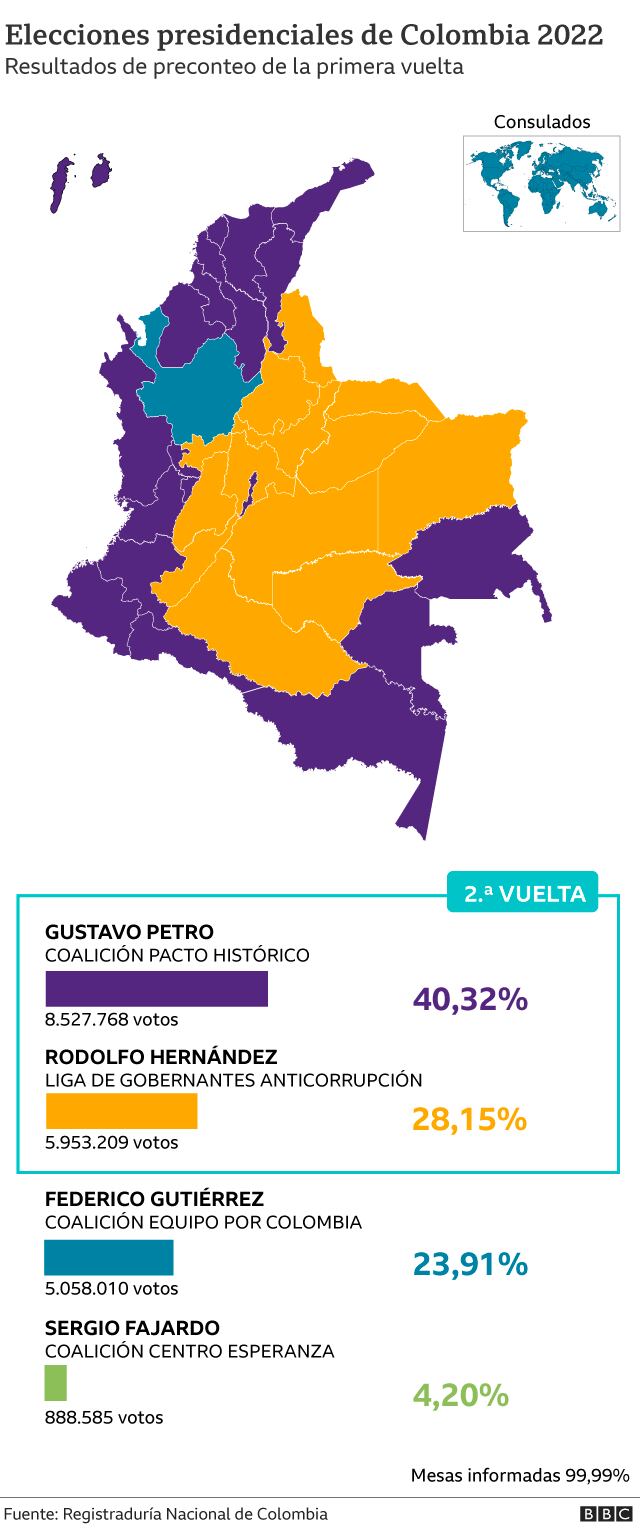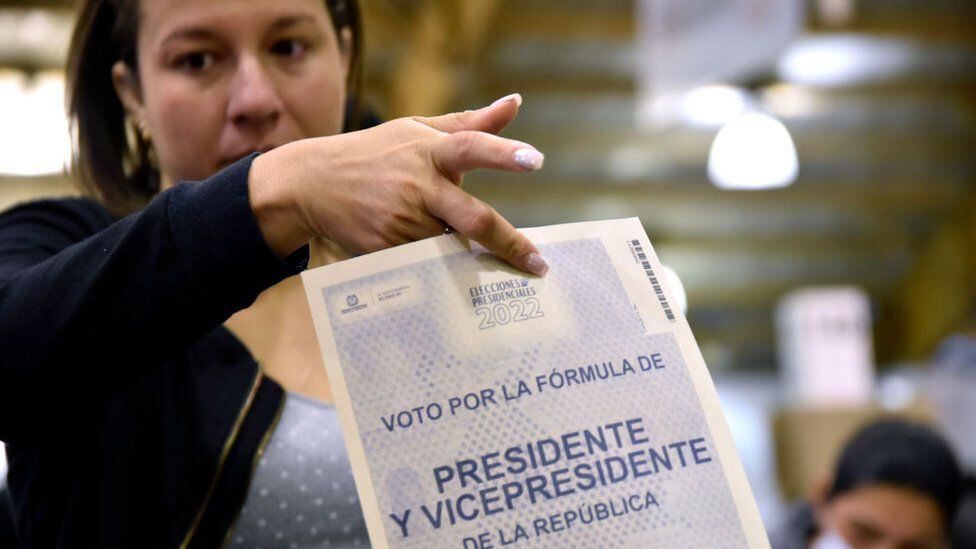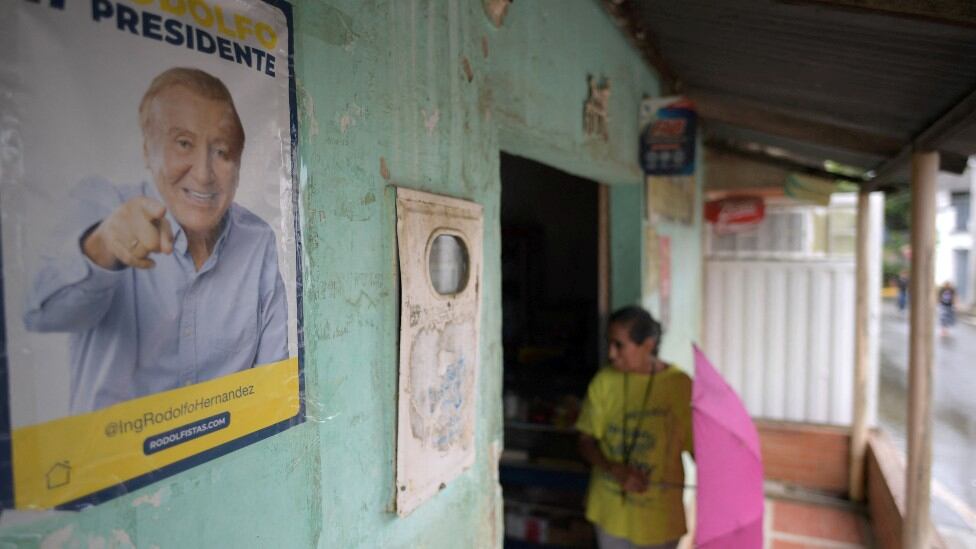the next president of Colombiaaccording to all estimates, will be defined by a few votes.
In the first round on May 29, the leftist senator and former mayor of Bogotá Gustavo Petro got 8.5 million votes and Rodolfo Hernandezbusinessman and former mayor of Bucaramanga, almost 6 million.
The difference seems great, but most of the polls for the second round show a technical tie.
And that’s because Hernandez, a outsider who rocked the campaign with blunt anti-politics and anti-corruption language, is likely to receive the majority of votes from the center and right that elected neither of them in the first round. This thanks to the fact that many fear a leftist government in what some called “Petrophobia”.
The candidates, then, are close. And in such a close election, every vote counts.
“When the election is most likely to be decided by a difference of 100,000 votes in a sea of 22 million, there is no place or segment that the candidates can dismiss”, says the pollster César Caballero.
LOOK: Rodolfo Hernández on Jaime Bayly’s program: “Petro is a Chavista and it doesn’t bother me to be compared to Trump”
What are the candidates doing?
Once the contenders for the second round were defined, both Petro and Hernández recalibrated their strategies.
After years of antagonizing the political system, and in the face of the emergence of Hernández, Petro now presents himself as the candidate for institutional and moderate change.
The candidate changed the discourse of the public square for smaller meetings with specific populations, such as miners and women, for example.
This Wednesday he slept in a popular neighborhood of Quibdó, an emblematic city of the Pacific. And the vice-presidential candidate France Marquez is touring those regions, as well as the coffee zone.
The objective is clear: try to increase their vote in areas where they already win, such as the Pacific and the Caribbean, to achieve the 11 million votes that would guarantee victory.

Hernández, for his part, has dedicated himself to weaving political alliances with political sectors that lost in the first round and that, beyond their differences with the engineer, fear a Petro government, which seeks to be the country’s first leftist president.
This Thursday, Hernández announced that he will refrain from public events for security reasons, a complaint that his opponent had also made before. And he insists that he will not engage in debates with Petro.
The strategy seems to be the same that has served him until now: promote his candidacy on social networks, avoid discussions of specific political projects and rely on the thousands of young people who distribute flyers and convince people on the streets of the entire country.
Both campaigns know that it will be a close second round and that they will win by avoiding mistakes, containing each other’s attacks and, above all, adding votes in certain regions and populations.

LOOK: How the dirty war comes out in the final stretch of the capresidential campaign in Colombia
The regions: the Caribbean, the coffee zone and Bogotá
The map of the winners in the first round in the 32 departments of the country shows a division similar to that of recent elections, which were defined by the polarization generated by the figure of Alvaro Uribe and the peace agreement with the guerrillas of the FARC.
While Hernández wins in the Andean region, the Uribista bastion where wealth is concentrated, Petro has an advantage in the poorest and most unequal areas of the country: the peripheries, on the Pacific and Caribbean coasts.
Silvia Otero, a political scientist at the Universidad del Rosario, points out that in the Caribbean, one of the traditionally crucial electoral zones, turnout on May 29 was 11 percentage points lower than the national average.
“If Petro manages to get more people to vote in their areas, there are many votes that did not count in the first round.“, He says.
That is why Petro focuses his campaign efforts there in the second round.

The surprising abstention in the Caribbean in the first round has no clear explanation, but it may be that the famous machinery, incentive schemes for people to vote for a certain candidate, were not activated. What is expected, say the experts, is that for the second the machinery will turn on.
“The most important population of the second round are the poor from the Caribbean coast who stayed at home, because without them Petro cannot increase its flowOtero says.
In the areas where Hernández won, such as his native Santander (in the east), turnout was already higher than usual, so it is unlikely that the picture will change in the second round. That is why the engineer has no other option than to mobilize the voters of the right and the center who will vote, above all, against Petro.
Where there can be a great dispute is in Bogotáa bastion of the left in which, however, Hernández had a surprisingly good performance.
“In Bogotá you have people for Petro and Hernández in the same house, and that makes it a very dangerous scenario for Petro, who is supposed to be very strong there.”, assures Otero.

And he adds that the coffee zone, an Andean region of three small departments (Caldas, Risaralda and Quindío) with large populations, also presents a very competitive scenario that can tilt for anyone.
In addition to these key areas, César Caballero, from the pollster Cifras yconcepts, draws attention to those small movements that may occur in areas where the difference was not so great in the first round.
“We know that Antioquia always votes to the right, but in its peripheral areas (Chocó and Urabá) Petro grew a lot; Rodolfo did very well in Boyacá, Cundinamarca, Tolima and Huila, but it remains to be seen if there in the second round the machines work the same after the adhesions (of the candidates defeated in the first round)”.
Gentleman insists: “We are in such a sensitive scenario, so mediated by the opinion vote (votes not linked to parties or consolidated figures), that it is impossible to assume things”.

LOOK: Who is the Petro adviser who recommended deploying a strategy against Fico Gutiérrez
key populations
According to the RCN News Presidential Tracking and the GAD3 consultancy, a survey focused on the race for the second round, in terms of gender the candidates have almost the same support.
However, during the last week Petro has tried to strengthen himself in feminist segments, due to Hernández’s comments that many describe as sexist. Support for the engineer among women has begun to fall in the aforementioned survey.
According to Otero, “Colombia is not at the same level of mobilization of feminism as, say, Chile, so women are going to be important to move minorities, but not masses”.
Those minorities, however, matter.
“For Petro, the vote of people concerned about the environment may be key, even if they are only 15,000 people, while for Hernández the support of the miners may be key.who are concerned about the environmentalist proposals of PetroKnight says.

In general, the studies show a narrow margin of advantage for one or the other in most segments, but there are some in which Petro has an advantage (poor and students) and others in which Hernández leads (retirees and private sector workers). ), according to the Presidential Tracking.
In these segments, the candidates can add votes, but in any case they have to maintain the support of the first round, in which there was a record participation of 54%, and avoid abstentionism.
Surveys have revealed that an unprecedented portion of Colombians believe that they will vote blank (6%) or are undecided (12%).
There may also be the key electorate that elects the president.
It is assumed that the growing blank vote favors Petro, because in theory they are votes from the first round that would not be added to Hernández, who starts with a disadvantage of two and a half million and who also has a volatile electorate.
In close elections like this, turnout is often high. And with so many people undecided days before the second round, it is difficult to know if one has a better chance than the other.
Source: Elcomercio
I, Ronald Payne, am a journalist and author who dedicated his life to telling the stories that need to be said. I have over 7 years of experience as a reporter and editor, covering everything from politics to business to crime.

:quality(75)/cloudfront-us-east-1.images.arcpublishing.com/elcomercio/GE4DCMRNGA3C2MJQKQYDAORRHA.jpg)

:quality(75)/cloudfront-us-east-1.images.arcpublishing.com/elcomercio/W6U6VJS5M5GAPCUQ3OFAXRF5QI.jpg)
:quality(75)/cloudfront-us-east-1.images.arcpublishing.com/elcomercio/332MGD7T6NCCXKGMSDO3YXX46A.jpg)


